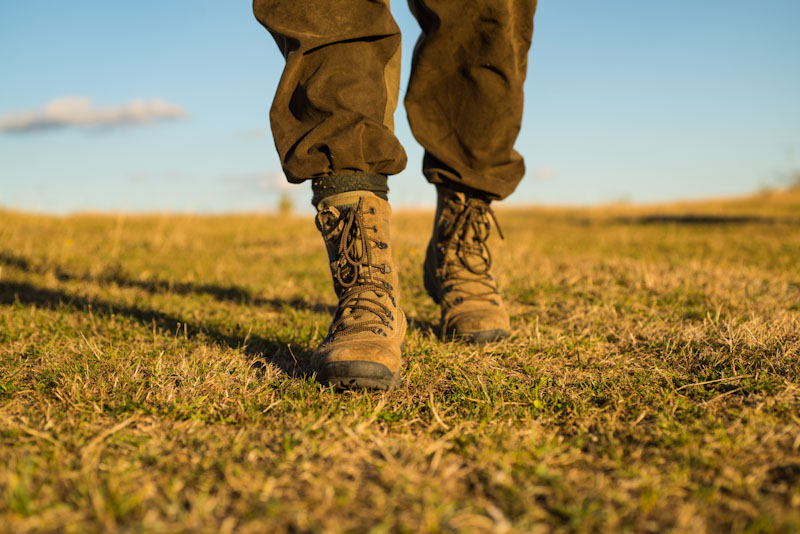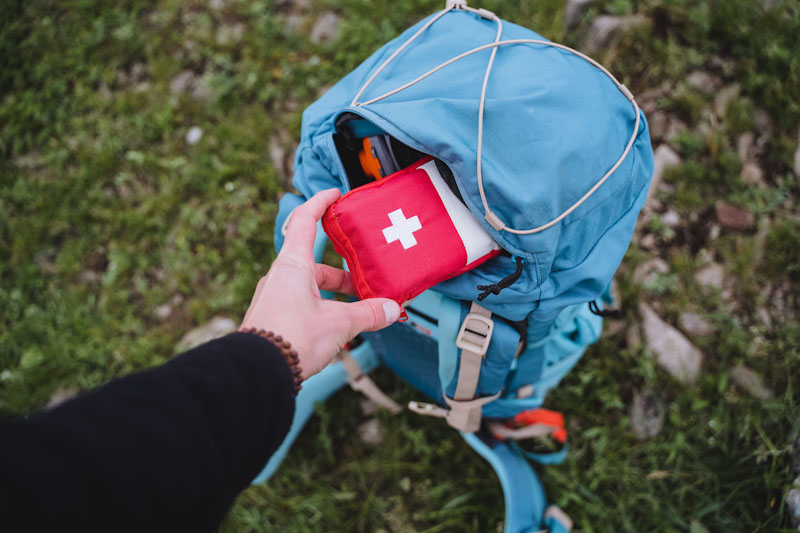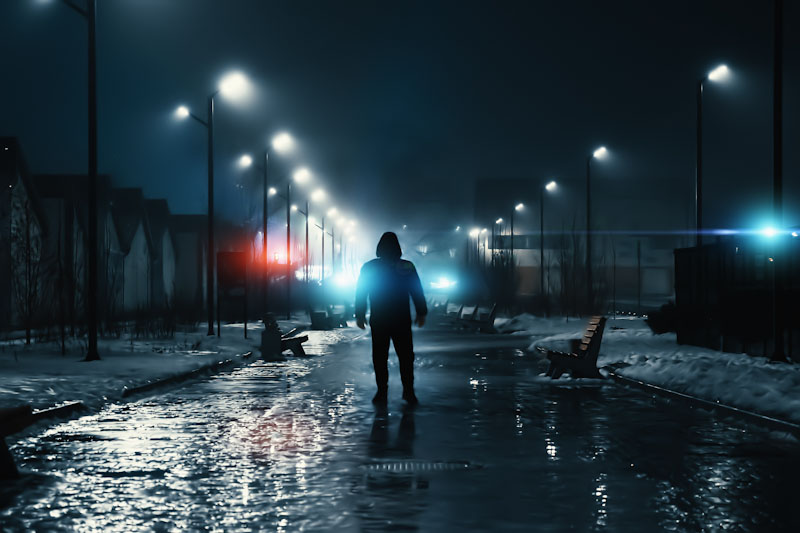Part 3 of 3
Group Tactics
Groups are generally more easily spotted and tracked than individuals, but they can mount a watch, put together more formidable ambushes, and may be able to make use of small unit tactics depending on training, group makeup, equipment, and so forth.
Most survivalists attempt to pattern survival groups after US military units, adopting their organization, equipment, and tactics, often because they themselves are former military and it’s what they know. I think that tactics, skills, and some of the basic equipment ports from military to survivalism just fine, but there are also some differences between military units and survival groups.
These include personnel makeup, age, fitness, and goals. Military units are comprised of military-trained, fit, military-age service members. Survival groups are mostly comprised of extended family and friends, like clans. If you put 120-pounds of packs, weapons, and load bearing equipment on a mom and dad who work desk jobs, 2.5 kids, grandma, and a golden retriever, they aren’t going to make it out of the driveway, much less far enough from the city for everyone else to run out of gas.
Not to mention that they’d have to be wealthy to afford all that equipment and a survival retreat in the first place. While a few types of military units train to work with less than others, the US military is backed up by the world’s largest logistics infrastructure. Survivalists who can fight probably have more in common with a partisan guerrilla fighter or a tribal warrior, and then you have the noncombatants.
Because of this, I think it’s worth it for survivalist to look at how nomadic clans and tribes organize and protect themselves and add that to parts of their existing paradigm that are effective for them.
How Nomadic Clans and Tribes Organize for Travel & Security
Most of the nomadic cultures I have studied divide the clan or tribe into at least two smaller groups when they travel. Whether on foot or mounted on animals, a faster moving scout/security element scouts ahead and provides security and a slower moving pack train makes use of travois, beasts of burden or both to carry supplies, children, elderly, infirm, and non-combatants.
This enabled the scout/security element to scout a safe route ahead of the main body, leaving trail signs that are interpreted and then scattered by the pack train, alerting them to resources and dangers. If the security element encountered a hostile force, it could alert the pack train and then use guerrilla hit and run tactics to draw them away or fight if they had to. Contacts with other clans and tribes was not always hostile. Contact with other clans and tribes was necessary for trade, intermarriage, the exchange of ideas and technologies, and to establish allies.
Before the reintroduction of horses to North America, Native Americans traveled on foot, by canoe, by kayak, and several tribes used dogs as pack animals.
When the pioneers migrated west, they adopted similar tactics with their wagon trains, dispatching scouting and hunting parties and circling the wagons and handcarts for protection. They learned to track and survive in the west and the necessity of planning travel based on available water sources and the changing seasons.
Step in the Tracks of the Person in Front of You
Waking single file, matching everyone’s stride to the shortest stride in the group, and stepping in each other’s footsteps helped to conceal the size of the party.
Apache Wars
To the embarrassment of the US Army, various Apache clans waged war against the US for over 90 years. I have walked battle sites in the 1980’s and assisted in an archeological excavation of Fort Thomas, built in Arizona to help prevent Geronimo from crossing back and forth between Mexico and the USA at will. Over 100 years later, rock breastworks were still visible and shell casings lay where they fell. By the caliber of the casings and the fact that Cavalry stomped their casings with their boot heels to prevent them from being reloaded by the Native Americans, we were able to compare the battle site to the after-action reports.
The troopers pursued the Apache up hill into canyons where they escaped. Their superior knowledge of the terrain, and endless tribal networks of safe houses and supply caches with extended family led to the practice of recruiting Native Americans to hunt Native Americans. In the end, despite massacres, famine, internment, reservations, brainwashing generations of school children, and the introduction of diseases to which they had no antibodies, the Apache were “pacified” after 5 generations of resistance only by the recruitment of their own people to hunt them.
Survivalists could learn much from Native American tribal supply and support networks. They cached supplies to avoid “putting all their eggs in one basket.” Children where taught the location of rendezvous points in 16 directions so they could run in any direction and knew where to find sanctuary and assistance.
Rodgers Rangers
Born of the American frontier, Major Rodgers based his tactics on frontier knowledge gained from Native Americans in North America rather than European land warfare. Below are his standing orders first published in 1759 and still included in the front of the Ranger Handbook. They remain a descent summation basic fieldcraft.
- “Don’t forget nothing.
- Have your musket clean as a whistle, hatchet scoured, sixty rounds powder and ball, and be ready to march at a minute’s warning.
- When you’re on the march, act the way you would if you was sneaking up on a deer. See the enemy first.
- Tell the truth about what you see and what you do. There is an army depending on us for correct information. You can lie all you please when you tell other folks about the Rangers, but don’t never lie to a Ranger or officer.
- Don’t never take a chance you don’t have to.
- When we’re on the march we march single file, far enough apart so one shot can’t go through two men.
- If we strike swamps, or soft ground, we spread out abreast, so it’s hard to track us.
- When we march, we keep moving till dark, so as to give the enemy the least possible chance at us.
- When we camp, half the party stays awake while the other half sleeps.
- If we take prisoners, we keep ’em separate till we have had time to examine them, so they can’t cook up a story between ’em.
- Don’t ever march home the same way. Take a different route so you won’t be ambushed.
- No matter whether we travel in big parties or little ones, each party has to keep a scout 20 yards ahead, 20 yards on each flank, and 20 yards in the rear so the main body can’t be surprised and wiped out.
- Every night you’ll be told where to meet if surrounded by a superior force.
- Don’t sit down to eat without posting sentries.
- Don’t sleep beyond dawn. Dawn’s when the French and Indians attack.
- Don’t cross a river by a regular ford.
- If somebody’s trailing you, make a circle, come back onto your own tracks, and ambush the folks that aim to ambush you.
- Don’t stand up when the enemy’s coming against you. Kneel down, lie down, hide behind a tree.
- Let the enemy come till he’s almost close enough to touch, then let him have it and jump out and finish him up with your hatchet.” (Rodgers, 2000)
-MAJOR ROBERT ROGERS 1759
Foot Travel Tactics & Fieldcraft
As discussed in Part 1, traveling cross country and by less-traveled backpacking trails and dirt roads, such as backpacking trails, rivers, waterways, rail lines, fire roads, and rights of way for power transmission lines, canals, and other infrastructure may be much safer to travel post-TEOTWAWKI than freeways, highways, and paved roads.
Footcare
Although footcare is not difficult, is often neglected. It starts with high-quality boots that fit right, are well broken in, and designed for the environment you will be operating in. Next, you will need at least three pairs of high quality seamless or flat seamed Merino wool blend socks.
Blisters and most other foot-related maladies start as “hot spots.” An alert backpacker can stop when a hot spot or discomfort is first perceived, change socks, apply moleskin, add a liner sock, adjusts boot laces, or trims a toenail before it gets serious. The alternative is to “cowboy up” and keep on hiking.
Becoming non-ambulatory in middle of nowhere is a bad idea now and a worse idea in TEOWAWKI. At a minimum, your footcare kit should include one of more changes of socks, a small pair of sharp, pointed scissors, a safety pin, and moleskin. I add Spenco 2nd Skin moist pads, Spenco 2nd Skin Adhesive Knit Dressing, Mole Foam, benzoin tincture, and a paper clip. I also add foot powder in the desert, tropics, and wet environments.
2nd Skin moist bandages and dressing are great for burst blisters and burns. Moleskin or a doughnut shaped oval of Mole Foam can prevent friction from making blisters worse. Benzoin tincture makes sure blister covering don’t come off. It is no easy task to create a dressing that will stay put on a sweaty foot on a backpacking trip. Benzoin tincture fills the bill and is great for 3M Steri-Strips, butterfly bandages and any bandage that you really need to stay put.
The paper clip is for crushing injuries to nail beds when they turn black and throb painfully with every heartbeat. When that happens, heat the paper clip until it glows and gently use it to burn a hole through the nail. As soon as it breaks through, blood will squirt out, bringing instant relief. I learned this trick from a medical tech and notice that Ray Mears also mentioned the tool in his book, Essential Bushcraft (Mears, 2002). To his credit, he mentioned nearly everything here save benzoin tincture.
Optics
Even a pocket monocular or small set of binoculars can be a great help on the trail, enabling you to spot others before they spot you and scan their waists, hands, and shoulders for weapons. Either will enable you to tell whether someone in the distance is a friend or a stranger.
Night vision and thermal imaging are more effective and less expensive than in the past. Such optics and the means to keep them in charged batteries, can give the survivor the ability to travel defend, at night, more effectively than others not so equipped.
Reducing Your Heat Signature
Thanks to the proliferation of thermal imaging technology, you may also need to manage your heat signature. This is hardest to do in winter where there is a big difference between body temperature and the surrounding terrain and air. Mountainous terrain, thick forest canopy, and multispectral camouflage clothing and netting are your friends. So is staying away from vehicles and running a cold camp.

How to Spot Trail Cameras
Try not to leave any actual time and date stamped photos by staying alert for trail cameras. The best way to spot trail cameras is to set up and use trail cameras. You will quickly learn that they must be mounted on a support, such as a tree, post, or stakes on lines of drift with unobstructed views of trails, kills, water, salt licks, and other areas of interest.
Pretty soon, you will be scanning supports with unobstructed views of trails about 2-3’ off the ground. And when you see something interesting in the trail, you’ll start thinking, “Looks like a trap.” instead of, “Oh, check out that ….”
The threat of trail cameras can also be mitigated somewhat by keeping your face covered, making identification less likely. If the cell system is working, some cameras can send images straight to mobile phones.
References
Carss, B. (1999). The Complete Guide to Tracking. London: Constable & Robinson Ltd.
Hurth, J. D. (2012). Combat Tracking Guide. Mechanicsburg, PA: Stackpole Books.
Mears, R. (2002). Medical Kit. In R. Mears, Essential Bushcraft (pp. 16-18). London: Hodder & Stoughton.
Rodgers, M. R. (2000). Standing Orders, Rodgers’ Rangers. In U. S. Army, Ranger Handbook SH 21-76 (p. I). United States Army.










Robert S. Stack | February 21, 2024
|
Hello: I just received and printed out Part 3 of your “Secure Foot Travel: Getting from A to B After the World Goes Sideways [Part 3]” but I’ve NEVER RECEIVED either your Part 1 or Part 2 of this very interesting informqtion so could you please email me those two prior segments and, while you’re at it, please tell your IT person that if this script gets any smaller (an IMPOSSIBILITY) no one will be able to read it at all so FIX THAT PLEASE!
Thank you,
Captain Robert S. Stack (Ret’d.)
U. S. Army Ranger (Airborne)
Vietnam & Central America
OUT!
john silvers | February 22, 2024
|
Fascinating detail, but I get the feeling if you’re reading this to learn now to travel in a SHTF scenario, you’re screwed anyway, so pull out the lawn chair, pop a top and get ready to meet your Maker in comfort and not in some God forsaken situation and place.